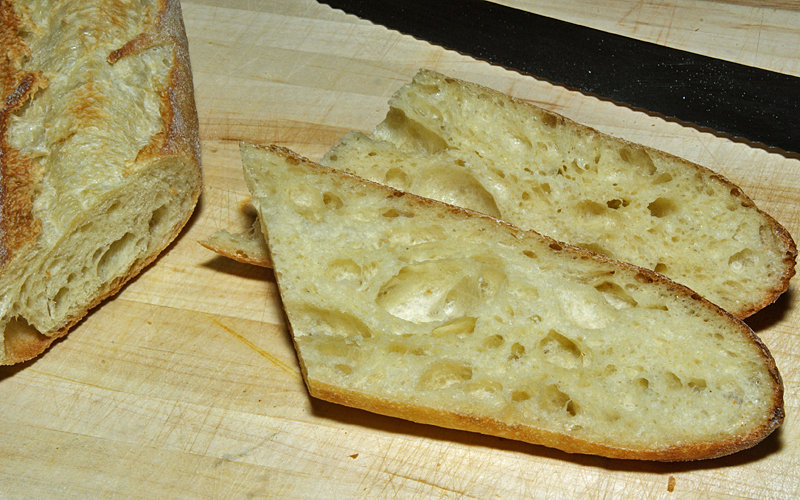This past year has been very interesting for me. I made learning rye breads a goal at the years end, and while I now know enough to understand it's going to take a lot longer, I'm making progress. Recently I did an experiment with scalding rye that worked out well. We have had some great threads here on the benefits of autolyse and mixing patterns. I was reminded of a post from Shiao-Ping where she made a Gerard Rubaud bread and another one from James Macguire that utilized long cool ferment at high hydration.
One thing that these breads have in common is hydration in the area of 80% and small amounts of yeast. This combination requires longer fermenting times and allows the development of flavorful acids. When handled gently, the bread that develops is airy and moist with great color and nutty after tastes.
I decided to make a single 900 gram loaf at 80% hydration. My plan was to start with a 90/10 ratio of AP/Dark Rye so it would darken well and hold moisture better than a straight white loaf. This is a plan for a small miche (if there is such a thing). Only the basic ingredients of flour, water, salt and yeast.This was a hand mixed dough. Just a plastic scraper, wire whisk, larger bowl and my hands were used. A key element to making this dough behave like I wanted was to control the water temperature so as to end up at a desired dough temperature of 70 degrees F. The natural reaction of the water being absorbed by the flour raises the temp by around 4 degrees F. So it's important to start near 70 at the warmest. My ambient room measures at 75F along with the flour.
The formula for adjusting the variable (water) follows. 215F - room temp - flour temp -5F = Water temp. For me this looks like 215F-75 -75 -5= 60F. When everything is mixed together the dough will be at or near 70F. Prof. Calvel and James Macguire both have made a point to stress that correct dough temp is the MOST important and critical aspect of making the dough you want. You just can't treat that as idle chatter form the masters and expect greatness in your oven. I like this bread because it can be made in a single day. In fact if you start at 11 AM, you should be done by 4ish, in time for dinner. The methods employed are from the old European school. My next batch will be with only 5% dark rye
Ingredients:
450g AP flour
50g Dark Rye flour
1/2 teaspoon Instant Dry Yeast (IDY)
10g Sea Salt
400g Water (cool)
Method:
Start by measuring the room and flour temperature and doing the calculation for the water temp. If you need to use ice to cool the water to arrive at a DDT of 70F, so be it.
Combine all dry ingredients in a large bowl and make sure the flours are well combined. Add water all at one time and stir with a spoon, switching to a scraper. This should involve no more than 2 minutes and should result in a rough mass with no dry flours in the bowl. Cover and rest for 20 minutes.
After 20 minutes, fold in the bowl for 8-10 repetitions rotating as you go. Alternatively, pour on the counter and fold with a scraper using double letter folds.Return to the bowl and cover.
Repeat the folding process every hour for a total of FOUR folds. That means 4 more folds after the first. When it is time for the last fold, don't fold, dust flour around the seam between the dough and the bowl and using the scraper, loosen the dough ball up so you can pour it out on a floured counter.
Brush any loose flour off the top of the dough and cover it with the bowl for about 20 minutes. Removing the bowl, pull the edges up to the center around the dough to tighten the lower surface and roll the ball over to the seamed side down. Prepare a linen lined basket with flour rubbed into the fabric and lightly dust the top of the dough. Roll the dough into your hands and place it into the basket seems up. Cover with a towel and proof for around 45 minutes. The dough will have become light and puffy and will test with the finger poke test.
Pre heat the oven to 450F when the dough goes into the basket using a stone and steam producer.
Load dough when it is ready and steam normally for 15 minutes. LOWER oven temp to 350F after the 15 minutes and start checking for done around 45 minutes total bake time. The idea is to bake the interior more slowly and not to over do it with color.
I left the loaf in the oven with the heat off and door ajar for another 5 minutes to help draw the moisture out. Remember it was an 80% hydrated mix. Cool and enjoy.
Eric


















